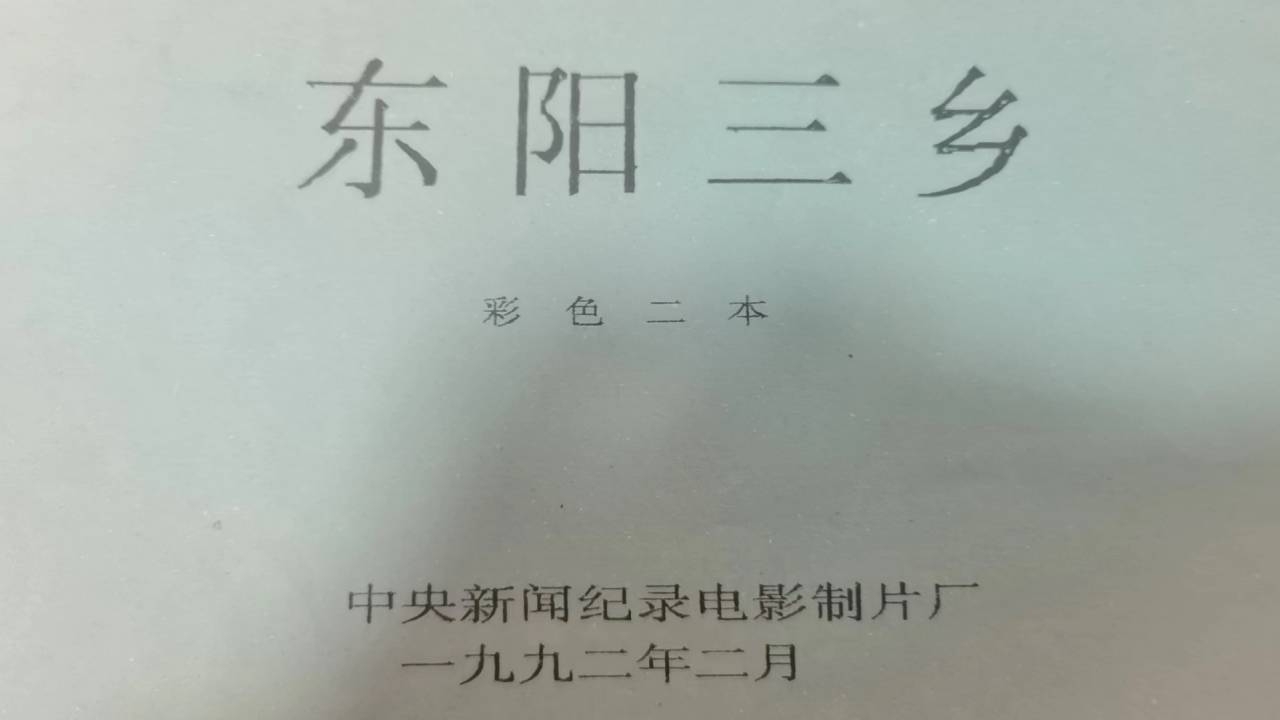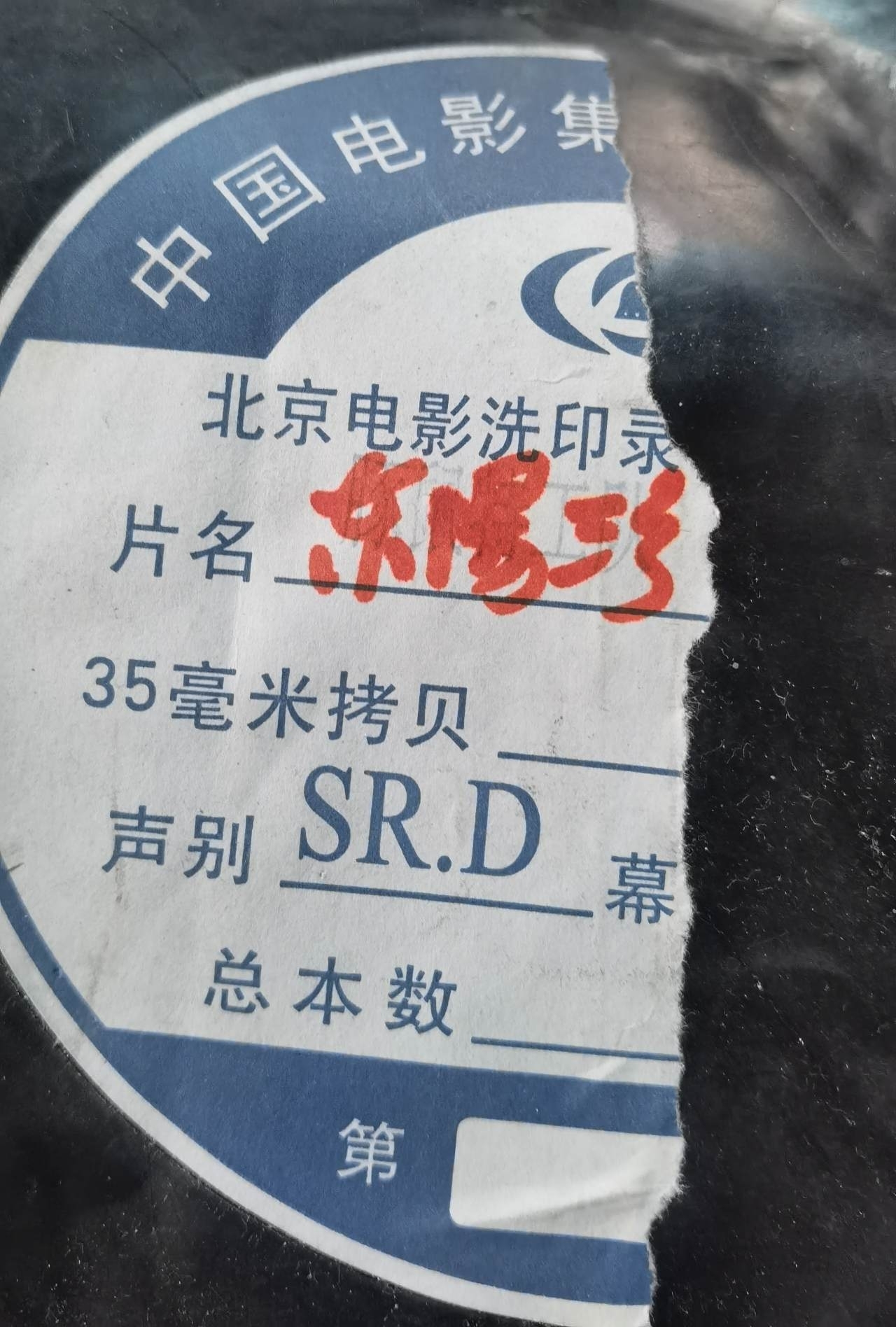The sparkling Dongyang River, the quaint and deep Cave Academy, the Dongyang Middle School where students gather, and the magnificent buildings of Ming and Qing Dynasties … Under the light, the scenery and characters on the copy are vivid and clear as yesterday, but from the perspective of architectural appearance and characters’ clothing, it is clearly the scene of the 1990s.

The script of "Dongyang Sanxiang" documentary film.
This is a copy of the documentary film "Three Villages in Dongyang" which was filmed in 1991, and it was revived with the filming script.
A message triggered the idea of searching.
This copy and script are collected by Xu Songtao, president of the Municipal Historical and Cultural Research Association.
"Last year, I saw a message posted by WeChat WeChat official account in Lishui Archives that a copy of the documentary film" Xiushan in Lishui "filmed in 1990 reappeared, which triggered the youthful memories of many local people. I couldn’t help but think of a similar documentary film in Dongyang." Xu Songtao said that in 1992, the unit organized everyone to go to the theater in Nanjie to watch the documentary film "Dongyang Sanxiang". Those beautiful and vivid pictures and incisive and beautiful explanations made him deeply intoxicated. "After more than 30 years, I have seen many promotional videos about Dongyang Sanxiang, but none of them are as comprehensive and in-depth as Dongyang Sanxiang, and they have incorporated profound thoughts and profound culture into the documentary lens." Therefore, after seeing this news, Xu Songtao interviewed many parties and finally found this copy and script in Hangzhou a few days ago.
According to the information on the cover of the script, Dongyang Sanxiang was filmed and produced by the Central News Recording Film Studio, and the script was completed in February 1992. "As far as I know, the Central News Recording Film Studio sent a film crew to Dongyang to shoot as early as 1991, and the script was mainly written for post-processing with commentary."
According to the investigation of Dongyang City Records, on October 12, 1991, the Central News Recording Film Studio came to Dongyang to shoot Dongyang Sanxiang.
The movie script hides the historical details.
Dongyang’s "three townships" are the hometown of education, architecture and arts and crafts. Documentary films are shot around this feature, and there are many details that are little known now.
For example, when explaining the hometown of arts and crafts, there is a horizontal plaque of "the hometown of all kinds of workers" in the film, because Dongyang was called "the hometown of all kinds of workers" in ancient times. The film thinks that the Ming and Qing architecture in Dongyang is "large-scale, regular in shape, exquisitely decorated with wood carvings and profound in noumenon", and takes Lu Zhai’s Ming architecture as proof. In order to reflect the development achievement of "Today, Dongyang Baigong not only inherits the traditional craft of ancient buildings, but also integrates it into modern buildings", the film crew specially visited and photographed Linping Hotel in Hangzhou, which was undertaken by Dongyang people from construction to decoration. The film introduced that the hotel completed the main building construction project in only 239 days, with high speed and good quality, and at the same time gave the hotel restaurant a number of close-ups of wood carving decoration. The film crew also went to Shanghai to film part of the project that won the "Magnolia Cup" and the Dongyang Mall. Dongyang Mall was originally planned to be completed in one and a half years, but "Dongyang people are tenacious" and it took only half a year to meet the first Arts and Crafts Festival in Dongyang. At the same time, the film pays attention to the vocational education of students in architectural schools, and focuses on the Dongyang women behind the architectural iron army in detail, thinking that Dongyang’s reputation as "the hometown of architecture" has the contribution of many mothers and wives.

Copy of Dongyang Sanxiang.
The film crew paid special attention to the characteristics of Dongyang’s "hometown of education". In addition to reflecting the report of People’s Daily "A hundred doctors meet in one city, and a thousand professors share the same hometown", they also dug up a lot of materials. For example, in the exhibition room of Dongyang Middle School at that time, there was an inscription by Li Chuanxin, a former deputy secretary of the Party Committee of Tsinghua University, "Talented people come forth in large numbers and have a long way to go". It turned out that in the college entrance examination in 1990, seven students from Dongyang Middle School were admitted to Tsinghua University with high scores, which attracted the attention of Li Chuanxin and made a special trip to Dongyang for inspection and inscription. The film also reflects two characteristics of Dongyang education in that period: first, it focused on the society, focused on educating people, and carried out educational diversion, so that some students could learn a skill in middle school. Taking the educational diversion practice of Nanshanghu Middle School as an example, this rural middle school opened professional courses such as breeding, woodcarving and machinery at that time; Second, in the education reform, the education department pooled the limited funds and set up experimental centers in sections, so that children in mountainous areas also have the opportunity to take experimental classes.
The film also explores the formation mechanism of Dongyang’s fashion of attaching importance to education and donating money to run schools. The example cited is still shocking today: Wu Huiguo’s father in Ganzhong Village (now Ganjing Community in Baiyun Street) is an ordinary farmer, and the old man left his son two words before he died: the law-abiding father-in-law is doing business and inheriting the tradition to build a first-class new school building. In accordance with his father’s wishes, Wu Huiguo donated 90,000 yuan of hard-earned money from a stall in Xining, Qinghai, to the village to build a brand-new primary school. "From this detail, it can be seen that donating money for education has always been a tradition in Dongyang, and the support of Dongyang people for education is indeed the best." Xu Songtao said that "Three Villages in Dongyang" still plays a very good role in preserving history and advising Dongyang. If the film can be shown again, it will be a very good education for Dongyang people.
Looking forward to the deep utilization of image data
Undoubtedly, Three Villages in Dongyang is a precious video material reflecting the development of Dongyang. Xu Songtao is currently looking for insiders and characters who know about the filming of this film, and at the same time, he is docking with relevant departments to try to digitally scan and re-show the copy.
The copy of Dongyang Sanxiang reappears in the light of day, and many Tibetan friends suggest developing the photos. It is reported that copying and washing requires special technical equipment and requires a lot of money. To this end, Xu Songtao is still striving for funds, preparing to develop some shots in the copy and exhibit them in the museum. Through in-depth exploration and development of this precious image file, he strives to tell the story of Dongyang and show the development and changes of Dongyang.
关于作者